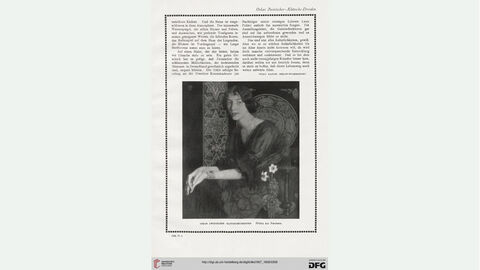During preparations for the 2022 exhibition Oskar Zwintscher and Art around 1900 at the Dresden State Art Collections, a search on the Lost Art website revealed a possibly problematic provenance for this Oskar Zwintscher painting, that had been in the Museum Wiesbaden’s collection since 2017. Subsequent in-depth research finally confirmed that the picture was indeed expropriated as a result of National Socialist persecution. As of July 1939, the 1905 Portrait with Daffodils was verifiably part of the art collection of Sigmund Waldes (1877-1961), who was persecuted as a Jew by the National Socialists.
Sigmund Waldes, Dresden
Since 1908, Sigmund Waldes had directed the Dresden branch of Waldes & Co., the metalware manufactory whose most well-known product was the Koh-i-noor press-stud. Together with his wife Ida Waldes, née Hirsch (1888-1977), starting in 1916 Waldes assembled a substantial art collection. No inventory of the collection has survived, but an impression of its contents may be gained from the 1929 catalogue of the Dresden-based Saxony Art Association’s Third Jubilee Exhibition: Recent Privately Owned Artworks from Dresden—to which the “factory owner Sigmund Waldes” is listed as loaning a total of 17 paintings, including a work by Oskar Zwintscher, though not the Portrait with Daffodils but the Red-haired Girl, dated 1895.
Securing Order and Confiscation of the Art Collection
The increasing pressure to which the Jewish entrepreneur and his family were subjected by National Socialist persecution forced them to emigrate to the United States in 1938. As a result of the “aryanisation” of the firm, the assets Sigmund Waldes left behind in Germany (to include his art collection) were placed under a so-called securing order by the Dresden Chief Finance President’s Foreign Exchange Office and in part impounded. A “record of the impounded objects” lists a total of 26 artworks, including, as item number 7, the “Portrait with Daffodils by Zwintscher”. When after his flight to the USA Waldes needed money, he was forced to sell the artworks left behind in Dresden through a trustee—the proceeds going to the German Reich. The Zwintscher painting very probably reached Berlin via the trustee, where it was sold on the open market.
The Painting and its Verifiable Provenance
Oskar Zwintscher’s Portrait with Daffodils, dated 1905, is mentioned several times in print from 1906 onwards. Thus, for instance, it was presented together with another portrait of a woman by the artist from June to October 1906 at the Third Exhibition of the German Artists’ Association in Weimar’s Grand Ducal Museum. In his review of the exhibition in the Leipzig newspaper Tagblatt, Georg Biermann (1880-1949) focused in particular on Oskar Zwintscher, who with his striking portraits of women so formidably steps beyond the bounds of convention (…) [1]
The portrait’s presence at the Mannheim International Art Exhibition for the months of May to October 1907 is also documented. The earliest black-and-white illustration of the painting is to be found in Willy Pastor’s (1867-1933) 1907 article on Oskar Zwintscher in the journal Deutsche Kunst und Dekoration [German Art and Decoration] (21.1907/08)—see photograph. One may assume that the work was at that point still in the artist’s possession—before in July 1908 it was sold at the Great Dresden Art Exhibition to a hitherto unknown buyer.
We are obliged to the art critic Franz Servaes (1862-1947) for a preliminary description of the portrait in his 1932 essay on Oskar Zwintscher:
In the Portrait with Daffodils, a work whose colours are especially delicately balanced, both flowers and a Gobelin tapestry principally serve decorative ends. Some such delightful background was needed to set off this uniquely fascinating young woman—in order to strengthen the impression of an enigma. [2]
After Oskar Zwintscher’s untimely death in February 1916, the Saxony Art Association in Dresden soon organized a comprehensive memorial exhibition for the following April, that included almost his entire oeuvre. In the accompanying catalogue, the painting is listed as belonging to “Franz Kühne, Schandau”. Exhaustive research efforts, however, have hitherto failed to unearth any further details on Franz Kühne, not even as to how long the painting was in his possession and when it entered the collection of Sigmund Waldes of Dresden. That he owned the work in July 1939 can be determined from the list of confiscated assets dated that month. There is afterwards no trace of the painting for several decades—even the 1999 catalogue raisonné of Oskar Zwintscher’s paintings notes: “location unknown”. [3]
Berlin Auction in November 2014
Only in November 2014 did the work—hitherto known solely through a black-and-white illustration in the Berlin auction house Grisebach’s catalogue, its provenance noted as “from private ownership, Saxony”—reappear. Ferdinand Wolfgang Neess acquired the work at this auction and in March 2017 donated it as part of his Jugendstil collection to the Museum Wiesbaden.
Fair and Just Settlement with the Heirs of Sigmund Waldes
In recognition of the persecution suffered by Sigmund Waldes under the National Socialist regime and the concomitant expropriation of his painting as a result of National Socialist persecution, in March 2024 the Museum Wiesbaden and the heirs of Sigmund Waldes agreed on a fair and just settlement whereby the work is to remain in the possession of the museum in return for payment of compensation.
The case prompted an extension of inquiries in the form of a special provenance research project on other paintings, pastel works and watercolors from the Neess collection (see Projects: Paintings and drawings from the F. W. Neess Donation).
Miriam Olivia Merz
[1] See Biermann, Georg: Die Künstlerbundausstellung in Weimar [The Artists‘ Association’s exhibition in Weimar], in: Leipziger Tageblatt, no. 323, 28. June 1906, p. 1 (culture section).
[2] See Servaes, Franz: “Oskar Zwintscher“, in: Velhagen & Klasings Monatshefte (vol. 1912/13), p. 85.
[3] See Rolf Günther, Oskar Zwintscher 1870-1916. Leben und Werk mit dem Werkverzeichnis der Gemälde [Life and work with catalogue raisonné of the paintings], Dresden 1999, no. 81.

